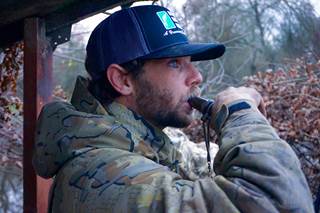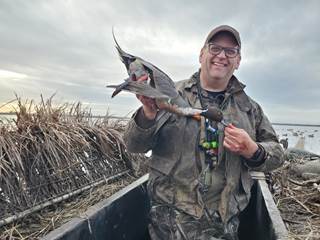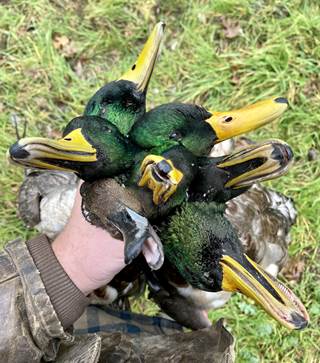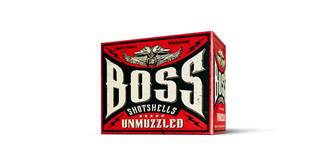California Dreaming
A trip to California’s Sacramento Valley delivers a bucket-list hunt for pintails, specklebellies, and mallards in a waterfowler’s paradise
A trip to California’s Sacramento Valley delivers a bucket-list hunt for pintails, specklebellies, and mallards in a waterfowler’s paradise
.jpg)
Dense. Gloomy. Pea soup. There were a number of ways I could have described the fog that blanketed the shallow pond and the mix of duck and goose floaters in front of me. I settled on a little bad luck.
My vantage point into the murk that January morning in northern California was from the right-hand side of a weathered, wood-framed blind. On the opposite end stood Daren Cole with Blue Heron Communications. Sandwiched between us was our guide, Ryley Haugh. Together, we were getting a hands-on look at Benellis new BE.S.T series of shotguns while hunting ducks and geese with Merlo Waterfowl Company near Oroville, in Californias Sacramento Valley.
Less than 100 yards in front of us flowed the waters of Butte Creek, and the oak trees that bordered the waterway marked the limit of my visibility. Still, the optimist in me decided that the fog was just an unfortunate, temporary twist on what was my first-ever California hunt.
Specks, 10 oclock, whispered Haugh in between yodels on his call. His heads-up sent my eyes skyward, where I spied a small flock of white-fronted geese over the creek. Our ears had been filled with the sounds of both white-fronted and snow geese all morning, but these birds were the first to emerge from the fog.
The geese maintained a line for our decoys until they reached the edge of shooting range, where they began to slide to the right. When Haugh called the shot, I was the only one with a realistic chance. I brought the 12-gauge Ethos to my shoulder, and the first load of 2 3/4-inch bismuth 4s from Boss Shotshells produced a Scotch double. I missed with my second shot before I connected again on my third.
Thats not a bad way to start the morning, Haugh laughed, before he snuck out the rear door of the blind to grab the geese.
Fog and all, I believed our luck had begun to change.
The Sacramento Valley is a part of Californias larger Central Valley, a vast area that serves as a major hub of agricultural production. Among the almond groves and rows of vegetables in the area are also rice fields that are flooded after harvest. There are also many public lands managed for waterfowl habitat. These resources are why the valley is regarded as an area of continental importance to waterfowl in the Pacific Flyway. Millions of ducks and geese depend on these habitats, including the aforementioned white-fronted geese and snow geese, as well as tundra swans, wigeon, green-winged teal, northern shovelers, and northern pintails.

In more than 30 years of waterfowl hunting across my home state of South Dakota and the prairie provinces of Canada, I had shot a number of pintails, but I had yet to take a drake pintail in full dressed-to-impress plumage, complete with a sprig that would make a long-tailed South Dakota rooster pheasant jealous. When the invitation arrived to hunt in the Sacramento Valley, the idea of shooting a prime bull sprig was foremost on my mind.
We didnt see a pintail that first morning, but we had opportunities for several other species as the fog lifted. Cole and I added a snow goose, mallards, and green-winged teal to the specks already hanging on the bird strap before we cased our Benellis and headed back to the lodge for breakfast.
On the drive back, the magic of the valley was on full display. Flocks of snow geese and swans flashed white against a metal-blue sky, while many of the rice fieldsknown locally as rice checks, according to Haughwere covered with specklebellies, mallards, shovelers, and, of course, pintails. There seemed to be water and waterfowl everywhere.
Haugh explained that heavy rains in the weeks before our hunt had caused a number of birds to move out of the region to take advantage of areas of new water.
The hunting has gotten much harder, he said.
Still, to my South Dakota eyes, this place looked like a waterfowl paradise.
Back at the lodge, other hunters had already returned, and their tagged birds were sitting outside, waiting to be taken to a local processor. Among the bag from the morning were a number of beautiful drake pintails. My jealousy must have been palpable.
You want a drake pintail, Haugh assured me, a hand on my shoulder. Well get you a drake pintail.
A short drive from the lodge in the afternoon put me along the edge of a flooded rice check, where small flocks of ducks, geese, and swans traded across the sky. I navigated the muddy walk along a levee and then settled into a pit blind with Holly Heyser, from the California Waterfowl Association, and Courtney Nicholson, from Delta Waterfowl, both of whom had filled their one-pintail limit that morning. They hoped to try out the Benelli/Boss combination on some afternoon specklebellies.
Haugh adjusted the decoys to match the wind that was moving right to left in front of the blind, while his yellow Lab, Buddy, inspected the spread. I used the time to visit with Heyser and Nicholson about their morning hunt, and they assured me that, based on their experience earlier in the day, I would get my chance to shoot a pintail.

Any doubts I had about their prediction were erased by the wings of a lone pintail that swung wide of the decoys not more than 10 minutes after Haugh joined us in the blind. Even at a distance, I could tell the drake was unlike any pintail I had encountered before, and when he folded with my first shot, I knew that Buddy was going to bring me a bucket-list bird.
In hand, the drake was simply stunning. The blue on its bill and array of other colors and feathers looked as if they had been painted by hand, its chest stained a rusty orange by the iron found in waters of the regions flooded rice fields. And that sprig!
Hold it up. Lets get a picture, Heyser instructed. Lets see a smile.
That wasnt hard to do.
I wasnt sure how my California experience could get any better after that first day of hunting, but the crew at Merlo Waterfowl Company made it happen.
Cole and I hunted together again the next morning over a massive spread of 50 dozen duck and goose decoys arranged near a pit blind in another rice field. Clear, starry skies gave way to a bank of fog that rolled in just before shooting time, and white-fronted geese were again the first visitors to our spread. In time, we added more specks, wigeon, and limits of trophy drake pintails to the straps. Throughout the morning, the skies were constantly filled with waterfowl on the move. And again on the drive back to the lodge, we saw thousands of ducks, geese, and swans feeding in the flooded rice fields.
Back at the lodge, Haugh apologized that the birds were so spread out, and that we hadnt shot full seven-bird limits of ducks on either of our first two hunts.
I didnt respond. In my head I was too busy thinking, You know, a guy could get used to this.

The author, John Pollmann, holding his prized California northern pintail.
The route from the lodge to the final mornings hunt followed a gravel road that ambled through almond and walnut groves before it reached a two-track path in an expanse of short green grass. After we ambled through the pasture for a mile, we met up with Haugh and Rocque Roc Merlo, owner of Merlo Waterfowl Company, and his young yellow Lab, Roxy.

Could be a good one this morning, said Merlo as we placed our gear in the back of a UTV for the final leg of the journey. Mallards, maybe some Canada geese. They have been using this pond to loaf throughout the day. The best part is that it hasnt been hunted all season.
When we pulled up to the edge of the pasture pond, I could see with the aid of the UTVs headlights that the surface of the water was littered with duck feathers. A better sight there is not.
Layout blinds were the choice of the day, and when covered with handfuls of the short green pasture grass, they made for perfect hides. Cole and I took positions on either end of the line of blinds. Once again, a bank of fog rolled in just before shooting light to obscure what had been clear skies. The stars, however, remained aligned.
Single drake, on the left, came a hushed voice from another blind. The mallard swung once in front of the blinds, circled around us, then swung out front again. A snappy five-note greeting call from Haugh sent the drake into a free-fall, orange feet down, wings pumping in rhythmic bursts. I was in position for the shot, and I made good with a load of Boss shells from the Ethos.
And so it went. Single greenheads and small flocks of mallards emerged from the fog, bending at the call, dropping into the decoys. Roxy deftly handled the retrieving duties until Cole and I had stacked up limits of mallards, with a handful of large Canada geese thrown in for good measure. South Dakota or California or anywhere in-between, it doesnt get much better than that.
Back at the trucks, Merlo asked me what I thought about the duck and goose hunting in northern California, and if it had lived up to my expectations.
It was everything I hoped it would be and then some, I replied.
The abundance and variety of waterfowl, the unique setting, and, of course, the pintails made this trip a dream come true.

The new Benelli Surface Treatment (BE.S.T.) line of shotguns features an unmatched level of protection from abrasion and corrosion that is designed to handle the harshest waterfowl hunting conditions. Our three days of hunting in California werent enough for us to see how the BE.S.T. coating stands up to long exposure to water, but we did note that there were no scratches or dings on the guns, even after being subject to wear and tear of hunting out of pit blinds and layout blinds. The BE.S.T. line is available in the Super Black Eagle 3, Ethos, and Ethos Cordoba and is backed by a 25-year warranty against rust and corrosion, all while delivering the reliability that has made Benelli a top choice for waterfowl hunters. benelliusa.com.
I packed my frozen, processed birds from the hunt in a YETI Hopper Flip 18 cooler with a pair of YETI ICE packs. After a full morning of bouncing around in the back of a truck and then eight hours of airports, air travel, and even more time in the back of a truck, the birds and ice packs were still frozen rock solid when I got home. yeti.com.

The hard-hitting, copper-plated, nontoxic shotshells from Boss are available in a wide variety of gauges and loads, including the 12-gauge 3-inch 3s and 2 3/4-inch 4s used by our group. Over three days of hunting, I used the 2 3/4-inch 4s to produce clean kills on mallards, pintails, green-winged teal, wigeon, white-fronted geese, snow geese, and large Canada geese over decoys. bossshotshells.com